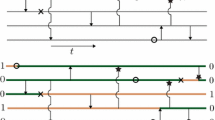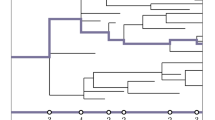Abstract
We consider the Moran model in continuous time with two types, mutation, and selection. We concentrate on the ancestral line and its stationary type distribution. Building on work by Fearnhead (J. Appl. Probab. 39 (2002), 38–54) and Taylor (Electron. J. Probab. 12 (2007), 808–847), we characterise this distribution via the fixation probability of the offspring of all individuals of favourable type (regardless of the offspring’s types). We concentrate on a finite population and stay with the resulting discrete setting all the way through. This way, we extend previous results and gain new insight into the underlying particle picture.




Similar content being viewed by others
Notes
Note the missing factor of 1/n in his Eq. (28).
References
Baake, E., & Bialowons, R. (2008). Ancestral processes with selection: branching and Moran models. Banach Cent. Publ., 80, 33–52.
Barton, N. H., Etheridge, A. M., & Sturm, A. K. (2004). Coalescence in a random background. Ann. Appl. Probab., 14, 754–785.
Birkhoff, G., & Rota, G. (1969). Ordinary differential equations (2nd ed.). Lexington: Xerox College Publ.
Durrett, R. (2002). Probability models for DNA sequence evolution. New York: Springer.
Durrett, R. (2008). Probability models for DNA sequence evolution (2nd ed.). New York: Springer.
Etheridge, A. M., & Griffiths, R. C. (2009). A coalescent dual process in a Moran model with genic selection. Theor. Popul. Biol., 75, 320–330.
Etheridge, A. M., Griffiths, R. C., & Taylor, J. E. (2010). A coalescent dual process in a Moran model with genic selection, and the Lambda coalescent limit. Theor. Popul. Biol., 78, 77–92.
Ewens, W. J. (2004). Mathematical population genetics. I. Theoretical introduction (2nd ed.). New York: Springer.
Fearnhead, P. (2002). The common ancestor at a nonneutral locus. J. Appl. Probab., 39, 38–54.
Ford, L. R. (1955). Differential equations (2nd ed.). New York: McGraw-Hill.
Karlin, S., & Taylor, H. M. (1981). A second course in stochastic processes. San Diego: Academic Press.
Kingman, J. F. C. (1982a). The coalescent. Stoch. Process. Appl., 13, 235–248.
Kingman, J. F. C. (1982b). On the genealogy of large populations. J. Appl. Probab., 19A, 27–43.
Krone, S. M., & Neuhauser, C. (1997). Ancestral processes with selection. Theor. Popul. Biol., 51, 210–237.
Mano, S. (2009). Duality, ancestral and diffusion processes in models with selection. Theor. Popul. Biol., 75, 164–175.
Neuhauser, C., & Krone, S. M. (1997). The genealogy of samples in models with selection. Genetics, 145, 519–534.
Norris, J. R. (1999). Markov chains. Cambridge: Cambridge University Press.
Pokalyuk, C., & Pfaffelhuber, P. (2013). The ancestral selection graph under strong directional selection. Theor. Popul. Biol. 87, 25–33.
Stephens, M., & Donnelly, P. (2003). Ancestral inference in population genetics models with selection. Aust. N. Z. J. Stat., 45, 901–931.
Taylor, J. E. (2007). The common ancestor process for a Wright-Fisher diffusion. Electron. J. Probab., 12, 808–847.
Vogl, C., & Clemente, F. (2012). The allele-frequency spectrum in a decoupled Moran model with mutation, drift, and directional selection, assuming small mutation rates. Theor. Popul. Biol., 81, 197–209.
Wakeley, J. (2008). Conditional gene genealogies under strong purifying selection. Mol. Biol. Evol., 25, 2615–2626.
Wakeley, J., & Sargsyan, O. (2009). The conditional ancestral selection graph with strong balancing selection. Theor. Popul. Biol., 75, 355–364.
Acknowledgements
It is our pleasure to thank Anton Wakolbinger for enlightening discussions, and for Fig. 2. We are grateful to Jay Taylor for valuable comments on the manuscript, and to Barbara Gentz for pointing out a gap in an argument at an earlier stage of the work. This project received financial support by Deutsche Forschungsgemeinschaft (DFG-SPP 1590), Grant no. BA2469/5-1.
Author information
Authors and Affiliations
Corresponding author
Appendix
Appendix
In Sect. 4.1, we have presented an alternative derivation of the boundary value problem for the conditional probability h. It remains to prove that \(\lim_{N \to \infty} h^{N}_{k_{N}} = h(x)\), with x∈[0,1], 0<k N <N, \(\lim_{N \to \infty} \frac{k_{N}}{N} = x\) and h as given as in (7).
Since \(h_{k}^{N} = \frac{k}{N} + \psi^{N}_{k}\) and h(x)=x+ψ(x), respectively, it suffices to show the corresponding convergence of the \(\psi^{N}_{k}\). For ease of exposition, we assume here that the process is stationary.
Lemma 3
Let \(\tilde{x}\) be as in (8). Then
Proof
Since the stationary distribution \(\pi^{N}_{Z}\) of \(( Z^{N}_{t} )_{t \geqslant 0}\) (cf. (2)) satisfies
for 1⩽n⩽N, Eq. (30) leads to
where we have used (1) in the last step. The stationary distribution of the rescaled process \(( X^{N}_{t} )_{t \geqslant 0}\) is given by \(( \pi^{N}_{X} ( \frac{i}{N} ) )_{0 \leqslant i \leqslant N}\), where \(\pi^{N}_{X} ( \frac{i}{N} ) = \pi^{N}_{Z} (i)\). Besides, the sequence of processes \((X^{N}_{t} )_{t \geqslant 0}\) converges to (X t ) t⩾0 in distribution, hence
as claimed. □
Remark 2
The proof gives an alternative way to obtain the initial value \(a^{}_{1}\) (cf. (18)) of recursion (15).
Theorem 3
For a given x∈[0,1], let \(( k_{N} )_{N \in \mathbb{N}}\) be a sequence with 0<k N <N and \(\lim_{N \to \infty} \frac{k_{N}}{N} = x\). Then
where ψ is the solution of the boundary value problem (11).
Proof
Using first Theorem 1, then (47), and finally (1), we obtain
In order to analyse the convergence of this expression, define
with step functions \(T^{N}_{k} : [0,1] \rightarrow \mathbb{R}\), \(\tilde{T}^{N}_{k} : [0,1] \rightarrow \mathbb{R}\) given by

Consider now a sequence \(( k_{N} )_{N \in \mathbb{N}}\) as in the assumptions. Then \(\lim_{N \to \infty} \pi^{N}_{Z} (k_{N}) = \pi^{}_{X}(x)\) (cf. Durrett, 2008, p. 319), and due to Lemma 3

Since \(T^{N}_{k}\) and \(\tilde{T}^{N}_{k}\) are bounded, we have
thus
Substituting on the right-hand side yields
where the second-last equality goes back to the definition of \(\tilde{x}\) in (8), and the last is due to (7), (10), and (5). □
Rights and permissions
About this article
Cite this article
Kluth, S., Hustedt, T. & Baake, E. The Common Ancestor Process Revisited. Bull Math Biol 75, 2003–2027 (2013). https://doi.org/10.1007/s11538-013-9871-0
Received:
Accepted:
Published:
Issue Date:
DOI: https://doi.org/10.1007/s11538-013-9871-0




